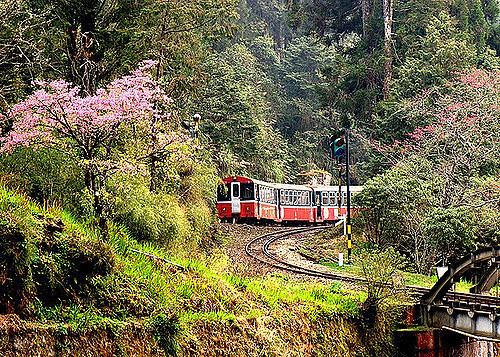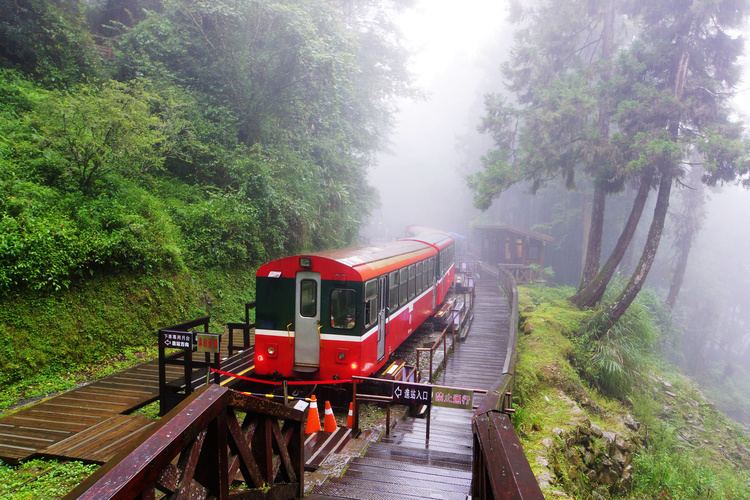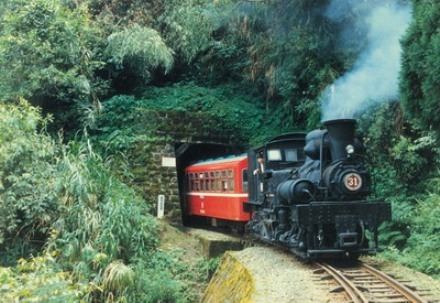Opened 1912 (1912) Track gauge 2 ft 6 in (762 mm) | Daily ridership 5500 Line length 86 km (53 mi) | |
 | ||
Terminis Alishan Station, Chiayi Station | ||
The alishan forest railway vacation travel video guide
The Alishan Forest Railway (Chinese: 阿里山森林鐵路; pinyin: Ālǐshān Sēnlín Tiělù) is an 86 km network of 2 ft 6 in (762 mm) narrow gauge railways running up to and throughout the popular mountain resort of Alishan in Chiayi County, Taiwan. The railway, originally constructed for logging, is itself a tourist attraction with unique Z-shaped switchbacks, 50 tunnels, and over 77 wooden bridges.
Contents
- The alishan forest railway vacation travel video guide
- Central taiwan alishan forest railway
- Empire of Japan
- Republic of China
- Operation
- References
Central taiwan alishan forest railway
Empire of Japan

The narrow gauge lines were originally constructed by the Japanese Colonial Government in 1912 to facilitate the logging of cypress and Taiwania wood. Passenger carriages were first added to the trains in 1918. The first motive power was a Shay locomotive purchased second hand from the Kiso Forest Railway in Japan. Eventually the railway acquired 20 Shay locomotives.

Eventually, diesel railcars supplemented the steam engines on the passenger services. In the 1980s, 10 Hitachi-built diesel-hydraulic locomotives were delivered and replaced the railcars and remaining steam engines.
Republic of China

The completion of the Alishan Highway in 1982 led to the loss of many rail passengers to faster and cheaper buses and the rail became primarily a tourist attraction.
Accidents on the line have resulted in a number of fatalities over the years. On 24 April 1981, a collapsed tunnel resulted in nine deaths and 13 injuries. On 1 March 2003, 17 people were killed and 156 injured when a train derailed near Alishan Railway Station. On 27 April 2011, five tourists, including three from mainland China, were killed and 113 people injured in a derailment.
The railway line was severely damaged by rains associated with 2009's Typhoon Morakot, with services only running between Chiayi and Fenqihu after the typhoon occurred. In August 2015, the Chiayi-Fenchihu railway sections were damaged due to Typhoon Soudelor, but these were opened again on 12 August 2015. On 15 September 2015, the whole rail line underwent its first test run since the damages made by the typhoon in 2009, and the line was reopened to the public on 25 December 2015.
Operation
Unlike the national rail system administered by the Taiwan Railway Administration (TRA), the Alishan Forest Railway is managed by the Council of Agriculture's (COA) Forestry Bureau. It was privatized through a build-operate-transfer (BOT) in June 2008 and maintained by the Hungtu Alishan International Development Corporation.
However, the Forestry Bureau terminated the contract with Hungtu after damage to the railway caused by Typhoon Morakot in 2009 was not repaired to its satisfaction. As of January 2011, the Forestry Bureau and Hungtu were still engaged in lawsuits over the issue to determine who has the right to manage the railway. In May 2011, the COA announce that it intended to transfer control of the railway to the TRA before the end of the year.
The system is currently operated using diesel locomotives, although there are occasional special public runs using the old steam powered Shay locomotives.
Taiwan's government has listed the forest railway as a potential World Heritage Site. However, Taiwan's exclusion from the United Nations means it is unlikely to be formally recognized as a WHS in the near future.
The main line runs from the city of Chiayi (elevation 30 m), to the final station of Alishan (elevation 2,216 m). The vegetation along the way changes from tropical to temperate and finally alpine. The line features many switchbacks on the way up the mountain.
